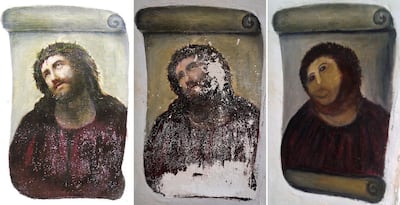In the latest case of botched art restoration in Spain, a repaired statue adorning the facade of a historic building in the city of Palencia has been ridiculed for its cartoonish appearance.
The statue, with its misaligned eyes, which look more like lips, and Olive Oyl-inspired nose, made headlines across the country as many took to social media to mock the inept makeover.
"It's more like a cartoon head than the artistic head of one of Palencia's most emblematic buildings," Antonio Guzman Capel, a painter in Palencia, wrote on Facebook in a post that shows before and after shots of the statue.

The statue is not the first artwork to have been rendered unrecognisable by mishandled restoration attempts.
In June, a copy of a painting of the Virgin Mary by the 17th-century Baroque artist Bartolome Esteban Murillo was ruined after a private art collector asked a furniture restorer to clean it for $1,350.

In 2018, a 500-year-old statue of St George in Navarre came under fire after a restoration, which many on social media remarked left the wooden sculpture looking like the comic-book character Tintin.
The local teacher behind the work, the church that commissioned the restoration and the company responsible were fined $6,840. The statue was restored back to its original state at an additional cost of $37,000 to the church.
In 2012, a parishioner in the Spanish town of Borja tried to restore a faded fresco of Christ by Elias Garcia Martinez titled Ecce Homo, only for it to end up as an ape-like character that became jokingly known as Ecce Mono or "Monkey Christ".
The series of bungled restorations have prompted conservation experts to demand more regulation in the field.
"We see this kind of thing time and time again and yet it keeps on happening," Fernando Carrera, a professor at the Galician School for the Conservation and Restoration of Cultural Heritage, told The Guardian in June. Spanish law permits people with no skills or experience to undertake a restoration project, he said.
“We need to invest in our heritage, but even before we talk about money, we need to make sure that the people who undertake this kind of work have been trained in it.”


